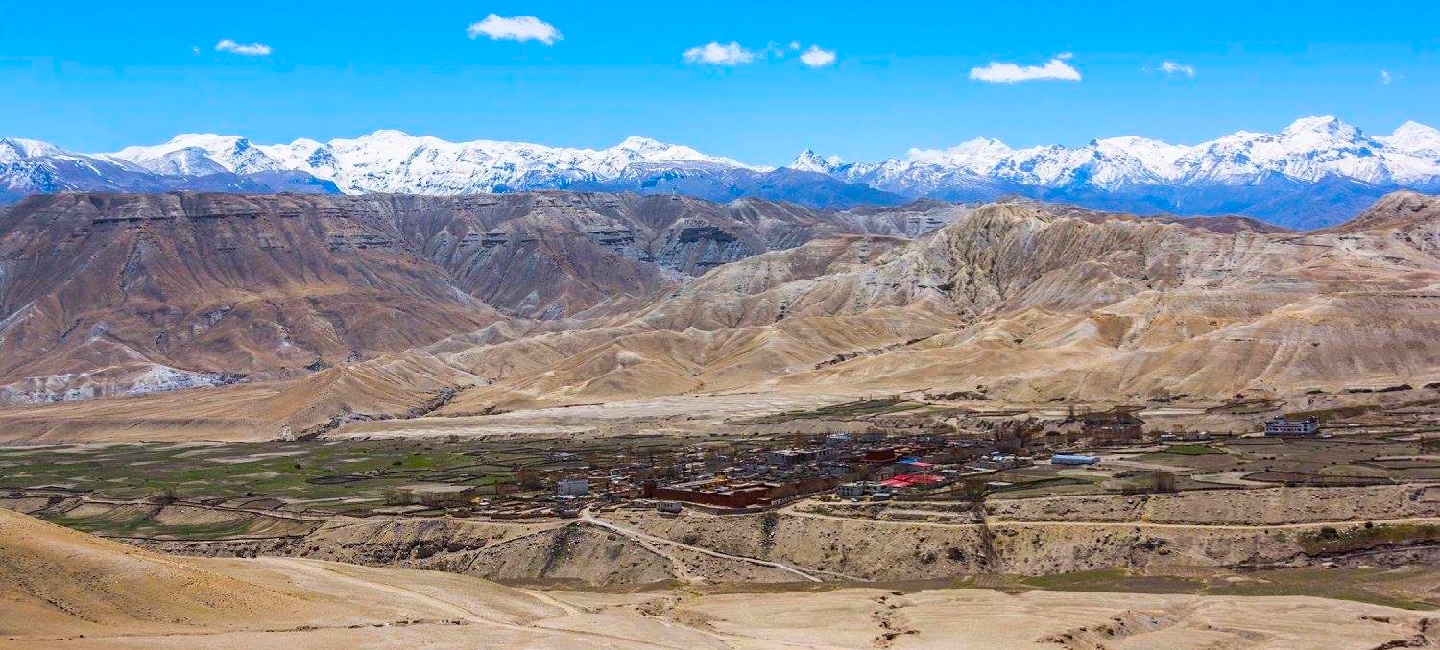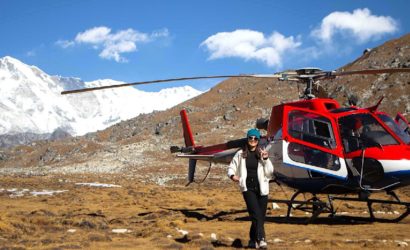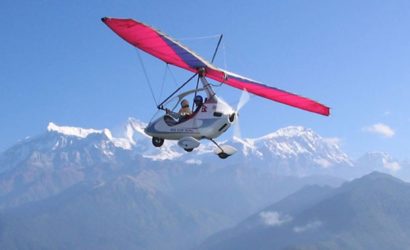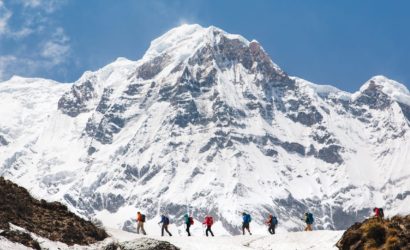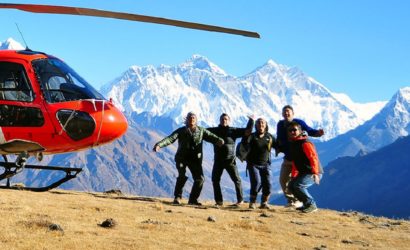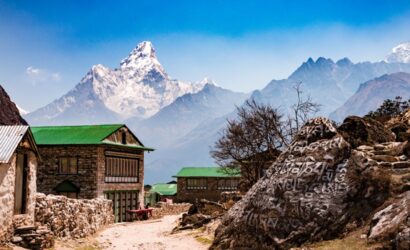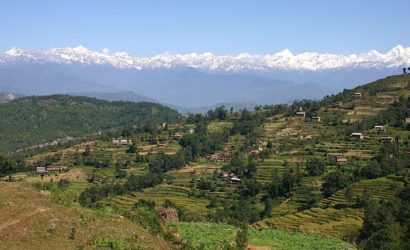Experience the majestic, barren landscapes of Lower Mustang dotted with Tibetan Buddhist cultural attractions on treks around Jomsom. The altitudes on this trip are not too high, and flying between Pokhara and Jomsom speeds the journey. This is an ideal trip for trekkers who don’t have much time or who prefer not to do a hard trek.
Lower Mustang trek is surrounded by two rivers – the Marshyangdi in the East and the Kali Gandaki in the West. The Kali Gandaki is famous for the shaligram shilas as well as the world’s deepest gorge. Promote Nepal as a desirable tourist destination.
Lower Mustang Trek Difficulty
The treks in the Jomsom area are moderately difficult. Muktinath is the highest point at 3710 meters, but all nights are spent below 3000 meters. It is suitable for both first-time and repeat travelers to Nepal, but requires a reasonable level of fitness and good health.
Getting Lower Mustang Trek & Away
A half-hour flight from Pokhara is the preferred mode of transportation to Jomsom, Lower Mustang trek.
Roads built in recent years have opened access to Jomsom and the Mustang area. As part of the Annapurna Circuit, it used to be popular to trek all the way along the Kali Gandaki Gorge to Jomsom (or opposite). Since the road completion, this is no longer ideal because the road is dusty and trekkers have to share it with vehicles.
You can take a jeep from Pokhara or a bus from Beni all the way to Jomsom instead of flying. It takes a full day and lowers the transportation cost, but be ready for a bumpy ride.
Upon your arrival in the Kathmandu airport after completing your custom formalities Visa, etc. pick up your luggage and look for our airport representative from Himalaya Discovery Adventures, who will display your name on the board at the arrival gate.
You will be greeted by our representative and transferred to your hotel by private tourist vehicle.
Today is free for sightseeing in Kathmandu. You may wish to visit Durbar Square in the heart of the old city where the old Royal Palace, with its intricate woodcarving is located. The whole area is a maze of temples and images. Leading away from the square in all directions are narrow alleys, full of the most amazing variety of shops and stalls.
Some of these landmarks are considered World Heritage Sites including the historic Bhaktapur Durbar Square, the famous ‘Monkey Temple’ Swayambhunath and Buddhists shrine Buddhanath which is one of the largest Stupas in the world.
There will also be a full trip briefing today with gear check. In case you need to hire or buy equipment locally there will be time to do this today.
Pokhara is a beautiful valley town, with panoramic views of Annurpurna, Machapuchare, and Dhaulagiri in the west, Lamjung Himal and Manaslu in the east.The town of Pokhara is considerably less hectic than Kathmandu.
Discover beautiful Fewa Lake, known for its tranquility and perfect picture postcards, or visit Devi Falls, a minor waterfall named after a tourist that fell inside. Overnight at hotel in Pokhara.
Breathtaking flight to Jomsom passing the Annapurna Range and Dhaulagiri.
Today, you’ll hike north to Kagbeni. The wide trail along the western side of the sandy, saligram-filled riverbed offers views of the nearby peaks of Dhaulagiri, Tukuche, and Nilgiri, as well as the Annapurna Massif to the south.
Kagbeni is the last village in Lower Mustang and guards the entrance into Upper Mustang. It is spectacularly situated atop a cliff overlooking the confluence of the Kali Gandaki and Jhong Khola rivers (visible across the Kali Gandaki riverbed). It is an oasis of green fields amidst rocky, arid mountains, with Nilgiri looming beyond.
With its narrow alleyways and tunnels, irrigation canals, green fields of barley, and 800-year-old brick-red Sayka Gompa, this ancient, partially ruined citadel town offers a glimpse into a unique way of life. You can also stroll past the 100-room King’s Palace.
A sign at the police checkpoint at the north end of the village reads, “Restricted area, tourists please do not go beyond this point.” This is the trail that leads up to the famous Lo Manthang in Upper Mustang’s ‘forbidden’ area.
You’ll want to eat a hearty breakfast this morning because the hiking begins today. It takes about 3-4 hours to walk from Kagbeni to Jharkot, depending on how you feel in the dry air and altitude.
It’s an uphill hike from Kagbeni to Jarkhot, and you gain quite a bit of elevation, so it’s nice to stop here and spend the afternoon exploring this old fortified village.
The striking red Gompa (monastery) of the Sakya sect of Buddhism, which sits prominently at the front of the village, is the village’s main feature.
This Gompa is over 500 years old and houses a Tibetan Medicine school. There are breathtaking views down the valley and up to the famous Thorong La pass.
Muktinath is an important pilgrimage site for both Buddhists and Hindus, and it is an example of a sacred site shared in harmony by followers of two religions. Local Buddhist nuns (from the lineage of Lama Wangyal) caretaker the site.
Thousands of devotees from India, Tibet, and Nepal come here on pilgrimage every year in seek of purification and salvation. Many kings throughout Asia are said to have done the same throughout history.
It’s well worth spending a day here not only to visit the sacred shrine but also to relax and enjoy in the beautiful surroundings.
You’ll descend to Jomsom via Lupra village, visiting the local Bonpo Monastery. While you have ascend the mountain for a short distance to rejoin the trail, it is a fantastic route that many trekkers on the Annapurna circuit miss out, so you will be far from the crowds and the jeep trail to Jharkot and Muktinath.
Bonpo is an ancient pre-Buddhist religion that is no longer represented by many monasteries, so this is a rare and special opportunity to learn about this ancient animist religion while taking a stunning alternate route back to Jomsom.
Following an early breakfast in Jomsom, you will be transferred to the local airstrip to your return flight to Pokhara. You’ll then catch a connecting flight to Kathmandu.
When you arrive, you will be taken to your hotel in the capital city. Spend the rest of the day on your own, perhaps exploring the streets by foot, bicycle, or rickshaw and seeing anything you missed at the start of your journey.
Today is rest and relax throughout the day. If you get interested to take some gifts from Nepal for friends and relatives, visit to some nearby shops or go out in Thamel for typical Nepalese goods.
Today, you can either stay back and enjoy a free day in Kathmandu or leave for your respective countries.
Our representatives will drop you off at the airport according to your flight schedule.

